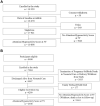Maternal pre-pregnancy obesity and offspring hyperactivity-inattention symptoms at 5 years in preterm and term children: a multi-cohort analysis
- PMID: 36307528
- PMCID: PMC9616941
- DOI: 10.1038/s41598-022-22750-8
Maternal pre-pregnancy obesity and offspring hyperactivity-inattention symptoms at 5 years in preterm and term children: a multi-cohort analysis
Abstract
The objective of this study was to determine the relationship between maternal pre-pregnancy body mass index (BMI) and child hyperactivity-inattention symptoms (HIS) at 5 years, including preterm and term-born children, and to determine whether this association varied with gestational age. Maternal pre-pregnancy BMI and offspring HIS were assessed in 10,898 participants born ≥ 33 weeks of gestation from the ELFE cohort and 2646 children born between 23 and 34 weeks from the EPIPAGE 2 cohort. Reported pre-pregnancy weight (kg) and measured height (m) were collected from mothers at inclusion and used to classify BMI (kg/m2). Child HIS were evaluated using the Strengths and Difficulties Questionnaire around 5 years of age. Logistic regression estimated odds ratios (OR) of a high HIS score (≥ 90th percentile) in the ELFE cohort and generalized estimated equations were used in EPIPAGE 2 to account for non-independence of multiple births. As a negative control, paternal BMI was also considered as an exposure of interest in sensitivity analyses. Maternal pre-pregnancy obesity and overweight were associated with child HIS at 5 years in ELFE (adjusted OR [aOR] for obesity 1.27 [1.06, 1.53]; overweight aOR 1.16 [1.00, 1.36]) and pre-pregnancy obesity was associated with high HIS scores in preterm infants of EPIPAGE 2 (aOR 1.48 [1.06, 2.08]). In ELFE, the magnitude of the association increased with decreasing gestational age (interaction p = 0.02). High maternal pre-pregnancy BMI is associated with greater likelihood of high HIS scores in both at-term and preterm children at 5 years of age.
© 2022. The Author(s).
Conflict of interest statement
The authors declare no competing interests.
Figures



Similar articles
-
Maternal Prepregnancy Obesity and Offspring Intelligence Quotient at 5 Years: A Multicohort Analysis.Paediatr Perinat Epidemiol. 2025 Feb;39(2):162-174. doi: 10.1111/ppe.13157. Epub 2025 Jan 7. Paediatr Perinat Epidemiol. 2025. PMID: 39777691 Free PMC article.
-
High maternal pre-pregnancy BMI is associated with increased offspring peer-relationship problems at 5 years.Front Child Adolesc Psychiatry. 2022 Oct 28;1:971743. doi: 10.3389/frcha.2022.971743. eCollection 2022. Front Child Adolesc Psychiatry. 2022. PMID: 39817281 Free PMC article.
-
Maternal pre-pregnancy BMI and offspring hyperactivity-inattention trajectories from 3 to 8 years in the EDEN birth cohort study.Eur Child Adolesc Psychiatry. 2023 Oct;32(10):2057-2065. doi: 10.1007/s00787-022-02047-x. Epub 2022 Jul 19. Eur Child Adolesc Psychiatry. 2023. PMID: 35851811
-
Association Between Maternal Body Mass Index in Early Pregnancy and Incidence of Cerebral Palsy.JAMA. 2017 Mar 7;317(9):925-936. doi: 10.1001/jama.2017.0945. JAMA. 2017. PMID: 28267854
-
Neonatal and neurodevelopmental outcomes in preterm infants according to maternal body mass index: A prospective cohort study.PLoS One. 2019 Dec 5;14(12):e0225027. doi: 10.1371/journal.pone.0225027. eCollection 2019. PLoS One. 2019. PMID: 31805081 Free PMC article.
Cited by
-
Maternal Obesity and Neurodevelopment of the Offspring.Nutrients. 2025 Mar 2;17(5):891. doi: 10.3390/nu17050891. Nutrients. 2025. PMID: 40077761 Free PMC article. Review.
-
Maternal Prepregnancy Obesity and Offspring Intelligence Quotient at 5 Years: A Multicohort Analysis.Paediatr Perinat Epidemiol. 2025 Feb;39(2):162-174. doi: 10.1111/ppe.13157. Epub 2025 Jan 7. Paediatr Perinat Epidemiol. 2025. PMID: 39777691 Free PMC article.
-
Trajectories of attention problems in preschoolers born very preterm.J Child Psychol Psychiatry. 2025 May;66(5):667-676. doi: 10.1111/jcpp.14074. Epub 2024 Nov 10. J Child Psychol Psychiatry. 2025. PMID: 39523488 Free PMC article.
-
Maternal Pregnancy and Pre-Pregnancy Weight and Behavioural Outcomes in Children.Behav Sci (Basel). 2024 Jan 12;14(1):49. doi: 10.3390/bs14010049. Behav Sci (Basel). 2024. PMID: 38247701 Free PMC article.
References
-
- Sayal K, Prasad V, Daley D, Ford T, Coghill D. ADHD in children and young people: Prevalence, care pathways, and service provision. Lancet Psychiatry. 2018;5:175–186. - PubMed
Publication types
MeSH terms
Grants and funding
LinkOut - more resources
Full Text Sources
Research Materials

